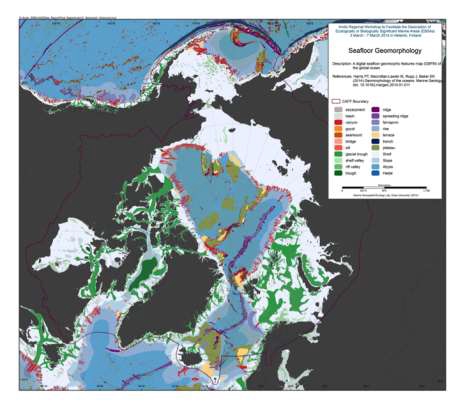Sea regions
Type of resources
Available actions
Topics
Keywords
Contact for the resource
Provided by
Years
Formats
Representation types
Update frequencies
status
Service types
Scale
-

We present the first digital seafloor geomorphic features map (GSFM) of the global ocean. The GSFM includes 131,192 separate polygons in 29 geomorphic feature categories, used here to assess differences between passive and active continental margins as well as between 8 major ocean regions (the Arctic, Indian, North Atlantic, North Pacific, South Atlantic, South Pacific and the Southern Oceans and the Mediterranean and Black Seas). The GSFM provides quantitative assessments of differences between passive and active margins: continental shelf width of passive margins (88 km) is nearly three times that of active margins (31 km); the average width of active slopes (36 km) is less than the average width of passive margin slopes (46 km); active margin slopes contain an area of 3.4 million km2 where the gradient exceeds 5°, compared with 1.3 million km2 on passive margin slopes; the continental rise covers 27 million km2 adjacent to passive margins and less than 2.3 million km2 adjacent to active margins. Examples of specific applications of the GSFM are presented to show that: 1) larger rift valley segments are generally associated with slow-spreading rates and smaller rift valley segments are associated with fast spreading; 2) polar submarine canyons are twice the average size of non-polar canyons and abyssal polar regions exhibit lower seafloor roughness than non-polar regions, expressed as spatially extensive fan, rise and abyssal plain sediment deposits – all of which are attributed here to the effects of continental glaciations; and 3) recognition of seamounts as a separate category of feature from ridges results in a lower estimate of seamount number compared with estimates of previous workers. Reference: Harris PT, Macmillan-Lawler M, Rupp J, Baker EK Geomorphology of the oceans. Marine Geology.
-
Norwegian Download service for INSPIRE Sea Regions.
-
<p>The data on observation of white whales (-lt;i-gt;Delphinapterus leucas-lt;/i-gt;) during the planned sailing of the research scientific ship "Mikhail Somov" (Arkhangelsk–Wrangel Island–Arkhangelsk) from September 6 to December 6 2010 are presented. The results obtained confirm and correct the existing ideas of the distribution of white whales and directions of their migrations in seas of the Russian Arctic.-nbsp;</p>
-
<p>Happywhale.com is a resource to help you know whales as individuals, and to benefit conservation science with rich data about individual whales.-nbsp;</p>
-
This Amphipoda dataset contains three parts: 1. Distribution records collected from literature; 2. Distribution records of specimens collected by the BioICE project (Benthic Invertebrates of Icelandic waters 1992-2004); 3. Distribution records of specimens collected by the IceAGE project (Icelandic marine animals: Genetics and Ecology, since 2011). The IceAGE data are outcome of two Amphipoda identification workshops held in Wilhelmshaven, Germany (2016) and Spala, Polen (2017).
-
<p>Abstract: Happywhale.com is a resource to help you know whales as individuals, and to benefit conservation science with rich data about individual whales.-nbsp;</p>
-
The North Atlantic and Arctic Isopoda dataset contains three parts: 1. Distribution records collected from literature; 2. Distribution records of specimens collected by the BIOICE project (Benthic Invertebrates of Icelandic waters 1992-2004); 3. Distribution records of specimens collected by the IceAGE project (Icelandic marine animals: Genetics and Ecology, since 2011). This dataset contains distribution data regarding the 2nd group, isopods occurrences sampled during the BIOICE project
-
This dataset contains Amphipod distribution records and is based on literature from the years 1931 to 2018. The data were collected during a variety of cruises and sampling events while the majority was obtained during the Danish Ingolf expedition. Sampling events took place in the North Atlantic and Arctic waters which included the Artic Ocean, Barents Sea, Kara Sea, Labrador Sea, Buffin Bay and Greenland Sea. Amphipods were predominantly collected using dredges, epibenthic sledges and remotely operated vehicles but scuba divers and vehicle-free baited traps were also used. This way, over 1566 Amphipod samples were collected in total which include 45 families, 117 genera and 164 species.
-
<p>Happywhale.com is a resource to help you know whales as individuals, and to benefit conservation science with rich data about individual whales.-nbsp;</p>
-
<p>Original provider: Happywhale Dataset credits: Happywhale and contributors Abstract: Happywhale.com is a resource to help you know whales as individuals, and to benefit conservation science with rich data about individual whales.-nbsp;</p>
 Arctic SDI catalogue
Arctic SDI catalogue